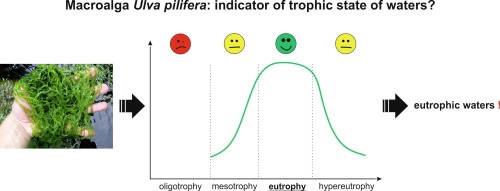Freshwater macroalga, Ulva pilifera (Ulvaceae, Chlorophyta) as an indicator of the trophic state of waters for small water bodies

Mass occurrence of green algae of the genus Ulva in the form of algal blooms (known as "green tides") is often associated with high concentrations of biogens in the water. Therefore, Ulva species are most often used in monitoring seawater trophy and far less frequently freshwater trophy. In Europe, the biomonitoring of river ecosystems is based on aquatic plants. According to the River Macrophyte Index (RMI), river populations of Ulva macroalgae (only tubular Enteromorpha-like Ulva) are considered good indicators for eutrophic waters. This paper analyses the legitimacy of using U. pilifera as a trophy indicator in the case of ponds. It has been noted that freshwater populations of U. pilifera are much more common in lakes, dammed reservoirs, or ponds than in rivers. In this study, analysed populations of U. pilifera originated from 14 ponds located in central Poland. Data analysis relied on the Carlson Trophic State Index (CTSI), which was compared with other known trophic indices. According to CTSI values, U. pilifera was most common in eutrophic ponds, where the mean concentrations of ammonium nitrogen, nitrates, total phosphorus, and chlorophyll a reached 581, 241, 212, and 20 µg·L−1, respectively. The results indicate that U. pilifera can be considered a bioindicator for eutrophic waters (50–70 of CTSI). It would therefore be appropriate to introduce U. pilifera as part of biomonitoring conducted in small bodies of water. Major arguments in favour of practical application of U. pilifera are: (i) it is a large macroalga, the thalli of which can reach a length of > 1.0 m, (ii) it is an easy-to-identify species; even by non-experts (it is characterized by a distinctive tubular shape of the thallus), and (iii) it occurs in bulk in conditions of eutrophy, creating an easily observable bloom.
Publisher URL: https://www.sciencedirect.com/science/article/pii/S1470160X20308906
DOI: 10.1016/j.ecolind.2020.106951
Keeping up-to-date with research can feel impossible, with papers being published faster than you'll ever be able to read them. That's where Researcher comes in: we're simplifying discovery and making important discussions happen. With over 19,000 sources, including peer-reviewed journals, preprints, blogs, universities, podcasts and Live events across 10 research areas, you'll never miss what's important to you. It's like social media, but better. Oh, and we should mention - it's free.
Researcher displays publicly available abstracts and doesn’t host any full article content. If the content is open access, we will direct clicks from the abstracts to the publisher website and display the PDF copy on our platform. Clicks to view the full text will be directed to the publisher website, where only users with subscriptions or access through their institution are able to view the full article.


